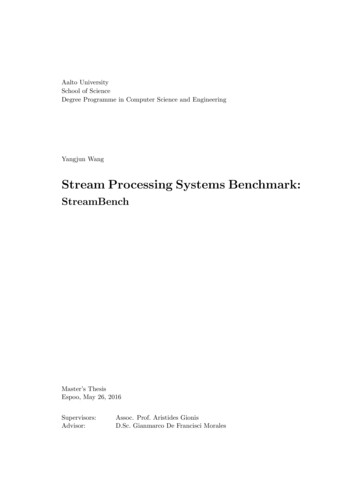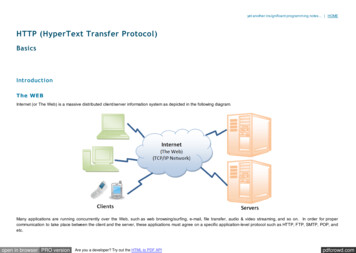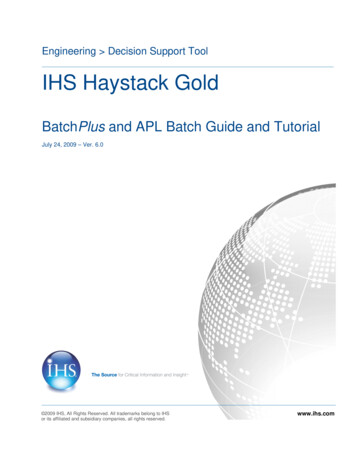
Transcription
Apache Flink : Stream and Batch Processing in a Single EngineParis Carbone†Asterios Katsifodimos*†KTH & SICS Swedenparisc,haridi@kth.seStephan Ewen‡Volker Markl*‡data Artisansfirst@data-artisans.comSeif Haridi†Kostas Tzoumas‡*TU Berlin & DFKIfirst.last@tu-berlin.deAbstractApache Flink1 is an open-source system for processing streaming and batch data. Flink is built on thephilosophy that many classes of data processing applications, including real-time analytics, continuous data pipelines, historic data processing (batch), and iterative algorithms (machine learning, graphanalysis) can be expressed and executed as pipelined fault-tolerant dataflows. In this paper, we presentFlink’s architecture and expand on how a (seemingly diverse) set of use cases can be unified under asingle execution model.1IntroductionData-stream processing (e.g., as exemplified by complex event processing systems) and static (batch) data processing (e.g., as exemplified by MPP databases and Hadoop) were traditionally considered as two very differenttypes of applications. They were programmed using different programming models and APIs, and were executed by different systems (e.g., dedicated streaming systems such as Apache Storm, IBM Infosphere Streams,Microsoft StreamInsight, or Streambase versus relational databases or execution engines for Hadoop, includingApache Spark and Apache Drill). Traditionally, batch data analysis made up for the lion’s share of the use cases,data sizes, and market, while streaming data analysis mostly served specialized applications.It is becoming more and more apparent, however, that a huge number of today’s large-scale data processinguse cases handle data that is, in reality, produced continuously over time. These continuous streams of data comefor example from web logs, application logs, sensors, or as changes to application state in databases (transactionlog records). Rather than treating the streams as streams, today’s setups ignore the continuous and timely natureof data production. Instead, data records are (often artificially) batched into static data sets (e.g., hourly, daily, ormonthly chunks) and then processed in a time-agnostic fashion. Data collection tools, workflow managers, andschedulers orchestrate the creation and processing of batches, in what is actually a continuous data processingpipeline. Architectural patterns such as the ”lambda architecture” [21] combine batch and stream processingsystems to implement multiple paths of computation: a streaming fast path for timely approximate results, and abatch offline path for late accurate results. All these approaches suffer from high latency (imposed by batches),Copyright 2015 IEEE. Personal use of this material is permitted. However, permission to reprint/republish this material foradvertising or promotional purposes or for creating new collective works for resale or redistribution to servers or lists, or to reuse anycopyrighted component of this work in other works must be obtained from the IEEE.Bulletin of the IEEE Computer Society Technical Committee on Data Engineering1The authors of this paper make no claim in being the sole inventors or implementers of the ideas behind Apache Flink, but rather agroup of people that attempt to accurately document Flink’s concepts and their significance. Consult Section 7 for acknowledgements.28
high complexity (connecting and orchestrating several systems, and implementing business logic twice), as wellas arbitrary inaccuracy, as the time dimension is not explicitly handled by the application code.Apache Flink follows a paradigm that embraces data-stream processing as the unifying model for real-timeanalysis, continuous streams, and batch processing both in the programming model and in the execution engine.In combination with durable message queues that allow quasi-arbitrary replay of data streams (like ApacheKafka or Amazon Kinesis), stream processing programs make no distinction between processing the latestevents in real-time, continuously aggregating data periodically in large windows, or processing terabytes ofhistorical data. Instead, these different types of computations simply start their processing at different pointsin the durable stream, and maintain different forms of state during the computation. Through a highly flexiblewindowing mechanism, Flink programs can compute both early and approximate, as well as delayed and accurate, results in the same operation, obviating the need to combine different systems for the two use cases. Flinksupports different notions of time (event-time, ingestion-time, processing-time) in order to give programmershigh flexibility in defining how events should be correlated.At the same time, Flink acknowledges that there is, and will be, a need for dedicated batch processing(dealing with static data sets). Complex queries over static data are still a good match for a batch processingabstraction. Furthermore, batch processing is still needed both for legacy implementations of streaming usecases, and for analysis applications where no efficient algorithms are yet known that perform this kind of processing on streaming data. Batch programs are special cases of streaming programs, where the stream is finite,and the order and time of records does not matter (all records implicitly belong to one all-encompassing window). However, to support batch use cases with competitive ease and performance, Flink has a specialized APIfor processing static data sets, uses specialized data structures and algorithms for the batch versions of operators like join or grouping, and uses dedicated scheduling strategies. The result is that Flink presents itself as afull-fledged and efficient batch processor on top of a streaming runtime, including libraries for graph analysisand machine learning. Originating from the Stratosphere project [4], Flink is a top-level project of the ApacheSoftware Foundation that is developed and supported by a large and lively community (consisting of over 180open-source contributors as of the time of this writing), and is used in production in several companies.The contributions of this paper are as follows: we make the case for a unified architecture of stream and batch data processing, including specific optimizations that are only relevant for static data sets, we show how streaming, batch, iterative, and interactive analytics can be represented as fault-tolerantstreaming dataflows (in Section 3), we discuss how we can build a full-fledged stream analytics system with a flexible windowing mechanism(in Section 4), as well as a full-fledged batch processor (in Section 4.1) on top of these dataflows, by showing how streaming, batch, iterative, and interactive analytics can be represented as streaming dataflows.2System ArchitectureIn this section we lay out the architecture of Flink as a software stack and as a distributed system. While Flink’sstack of APIs continues to grow, we can distinguish four main layers: deployment, core, APIs, and libraries.Flink’s Runtime and APIs. Figure 1 shows Flink’s software stack. The core of Flink is the distributed dataflowengine, which executes dataflow programs. A Flink runtime program is a DAG of stateful operators connectedwith data streams. There are two core APIs in Flink: the DataSet API for processing finite data sets (oftenreferred to as batch processing), and the DataStream API for processing potentially unbounded data streams(often referred to as stream processing). Flink’s core runtime engine can be seen as a streaming dataflow engine,and both the DataSet and DataStream APIs create runtime programs executable by the engine. As such, it servesas the common fabric to abstract both bounded (batch) and unbounded (stream) processing. On top of the core29
Task Manager #1Job ManagerCloudGoogle Comp. Engine,EC2Checkpoint CoordinatorFigure 1: The Flink software stack.TaskSlotMemory/IO ManagerDataStreamsTask Manager #2 TaskSlotTaskSlotTaskSlotActor SystemClusterStandalone, YARNSchedulerTaskSlotNetwork ManagerDataflow GraphRuntimeDistributed Streaming DataflowLocalSingle JVM,EmbeddedTaskSlotActor SystemGraph Builder & OptimizerActor SystemDataflow GraphDataStream APIStream ProcessingFlink ProgramTask StatusHeartbeatsStatisticsTrigger Checkpoints, r et ur n i ( x * x y * y 1) ? 1 : 0 );Actor Systemd ou bl e y Ma th .r an do m( );}} ) ;Table APIStreamingCEPComplex EventProcessingTable APIBatchGellyGraph API/LibraryFlink MLMachine LearningDeployE xe cu ti on En vi ro nm en t en v Ex ec ut io nE nv ir on me nt .g et Ex ec ut io nE nv ir on me nt () ;D a t a S e t I tn eg re ti er at io n in it ia l. ma p( ne w Ma pF un ct io n In te ge r, I nt eg er ( ) {@ O v er ri dep u b il c In te ge r ma (p In et ge r i) t hr ow s Ex ce pt io n {d ou lb e x aM th r. an od m( ;)DataSet APIBatch ProcessingCoreAPIs & LibrariesFlink Clientf i n a l/ / C r e a te i ni ti al I te ra ti ve Da ta Se tI t e r a t i ve Da ta Se t In te ge r i ni ti al e nv .f ro mE le me nt (s 0) .i te ra te (1 0 0 );Figure 2: The Flink process model.Memory/IO ManagerNetwork ManagerAPIs, Flink bundles domain-specific libraries and APIs that generate DataSet and DataStream API programs,currently, FlinkML for machine learning, Gelly for graph processing and Table for SQL-like operations.As depicted in Figure 2, a Flink cluster comprises three types of processes: the client, the Job Manager, andat least one Task Manager. The client takes the program code, transforms it to a dataflow graph, and submitsthat to the JobManager. This transformation phase also examines the data types (schema) of the data exchangedbetween operators and creates serializers and other type/schema specific code. DataSet programs additionallygo through a cost-based query optimization phase, similar to the physical optimizations performed by relationalquery optimizers (for more details see Section 4.1).The JobManager coordinates the distributed execution of the dataflow. It tracks the state and progress of eachoperator and stream, schedules new operators, and coordinates checkpoints and recovery. In a high-availabilitysetup, the JobManager persists a minimal set of metadata at each checkpoint to a fault-tolerant storage, such thata standby JobManager can reconstruct the checkpoint and recover the dataflow execution from there. The actualdata processing takes place in the TaskManagers. A TaskManager executes one or more operators that producestreams, and reports on their status to the JobManager. The TaskManagers maintain the buffer pools to buffer ormaterialize the streams, and the network connections to exchange the data streams between operators.3The Common Fabric: Streaming DataflowsAlthough users can write Flink programs using a multitude of APIs, all Flink programs eventually compile downto a common representation: the dataflow graph. The dataflow graph is executed by Flink’s runtime engine, thecommon layer underneath both the batch processing (DataSet) and stream processing (DataStream) APIs.3.1Dataflow GraphsThe dataflow graph as depicted in Figure 3 is a directed acyclic graph (DAG) that consists of: (i) statefuloperators and (ii) data streams that represent data produced by an operator and are available for consumptionby operators. Since dataflow graphs are executed in a data-parallel fashion, operators are parallelized intoone or more parallel instances called subtasks and streams are split into one or more stream partitions (onepartition per producing subtask). The stateful operators, which may be stateless as a special case implementall of the processing logic (e.g., filters, hash joins and stream window functions). Many of these operatorsare implementations of textbook versions of well known algorithms. In Section 4, we provide details on theimplementation of windowing operators. Streams distribute data between producing and consuming operatorsin various patterns, such as point-to-point, broadcast, re-partition, fan-out, and merge.30
100SRC1IS1OP1Materialized IntermediateData Stream(blocking data exchange)Stateful OperatorSRC2SNK1IS3IS2SNK2Control EventData RecordOperator StateTransient IntermediateData Stream (pipelined data exchange)80708060605040403020201000051050100Buffer timeout (milliseconds)Figure 3: A simple dataflow graph.3.2Latency99th-percentile in milliseconds90100Throughput(Average in millions of events/sec)120Figure 4: The effect of buffer-timeoutin latency and throughput.Data Exchange through Intermediate Data StreamsFlink’s intermediate data streams are the core abstraction for data-exchange between operators. An intermediatedata stream represents a logical handle to the data that is produced by an operator and can be consumed by oneor more operators. Intermediate streams are logical in the sense that the data they point to may or may not bematerialized on disk. The particular behavior of a data stream is parameterized by the higher layers in Flink(e.g., the program optimizer used by the DataSet API).Pipelined and Blocking Data Exchange. Pipelined intermediate streams exchange data between concurrentlyrunning producers and consumers resulting in pipelined execution. As a result, pipelined streams propagateback pressure from consumers to producers, modulo some elasticity via intermediate buffer pools, in orderto compensate for short-term throughput fluctuations. Flink uses pipelined streams for continuous streamingprograms, as well as for many parts of batch dataflows, in order to avoid materialization when possible. Blockingstreams on the other hand are applicable to bounded data streams. A blocking stream buffers all of the producingoperator’s data before making it available for consumption, thereby separating the producing and consumingoperators into different execution stages. Blocking streams naturally require more memory, frequently spill tosecondary storage, and do not propagate backpressure. They are used to isolate successive operators againsteach other (where desired) and in situations where plans with pipeline-breaking operators, such as sort-mergejoins may cause distributed deadlocks.Balancing Latency and Throughput. Flink’s data-exchange mechanisms are implemented around the exchange of buffers. When a data record is ready on the producer side, it is serialized and split into one or morebuffers (a buffer can also fit multiple records) that can be forwarded to consumers. A buffer is sent to a consumereither i) as soon as it is full or ii) when a timeout condition is reached. This enables Flink to achieve highthroughput by setting the size of buffers to a high value (e.g., a few kilobytes), as well as low latency by settingthe buffer timeout to a low value (e.g., a few milliseconds). Figure 4 shows the effect of buffer-timeouts on thethroughput and latency of delivering records in a simple streaming grep job on 30 machines (120 cores). Flinkcan achieve an observable 99th -percentile latency of 20ms. The corresponding throughput is 1.5 million eventsper second. As we increase the buffer timeout, we see an increase in latency with an increase in throughput,until full throughput is reached (i.e., buffers fill up faster than the timeout expiration). At a buffer timeout of50ms, the cluster reaches a throughput of more than 80 million events per second with a 99th -percentile latencyof 50ms.Control Events. Apart from exchanging data, streams in Flink communicate different types of control events.These are special events injected in the data stream by operators, and are delivered in-order along with all other31
Figure 5: Asynchronous Barrier Snapshotting.data records and events within a stream partition. The receiving operators react to these events by performingcertain actions upon their arrival. Flink uses lots of special types of control events, including: checkpoint barriers that coordinate checkpoints by dividing the stream into pre-checkpoint and postcheckpoint (discussed in Section 3.3), watermarks signaling the progress of event-time within a stream partition (discussed in Section 4.1), iteration barriers signaling that a stream partition has reached the end of a superstep, in Bulk/StaleSynchronous-Parallel iterative algorithms on top of cyclic dataflows (discussed in Section 5.3).As mentioned above, control events assume that a stream partition preserves the order of records. To this end,unary operators in Flink that consume a single stream partition, guarantee a FIFO order of records. However,operators receiving more than one stream partition merge the streams in arrival order, in order to keep up withthe streams’ rates and avoid back pressure. As a result, streaming dataflows in Flink do not provide orderingguarantees after any form of repartitioning or broadcasting and the responsibility of dealing with out-of-orderrecords is left to the operator implementation. We found that this arrangement gives the most efficient design, asmost operators do not require deterministic order (e.g., hash-joins, maps), and operators that need to compensatefor out-of-order arrivals, such as event-time windows can do that more efficiently as part of the operator logic.3.3Fault ToleranceFlink offers reliable execution with strict exactly-once-processing consistency guarantees and deals with failuresvia checkpointing and partial re-execution. The general assumption the system makes to effectively providethese guarantees is that the data sources are persistent and replayable. Examples of such sources are files anddurable message queues (e.g., Apache Kafka). In practice, non-persistent sources can also be incorporated bykeeping a write-ahead log within the state of the source operators.The checkpointing mechanism of Apache Flink builds on the notion of distributed consistent snapshotsto achieve exactly-once-processing guarantees. The possibly unbounded nature of a data stream makes recomputation upon recovery impractical, as possibly months of computation will need to be replayed for a longrunning job. To bound recovery time, Flink takes a snapshot of the state of operators, including the currentposition of the input streams at regular intervals.The core challenge lies in taking a consistent snapshot of all parallel operators without halting the executionof the topology. In essence, the snapshot of all operators should refer to the same logical time in the computation.The mechanism used in Flink is called Asynchronous Barrier Snapshotting (ABS [7]). Barriers are controlrecords injected into the input streams that correspond to a logical time and logically separate the stream to thepart whose effects will be included in the current snapshot and the part that will be snapshotted later.An operator receives barriers from upstream and first performs an alignment phase, making sure that thebarriers from all inputs have been received. Then, the operator writes its state (e.g., contents of a sliding window,or custom data structures) to durable storage (e.g., the storage backend can be an external system such as HDFS).Once the state has been backed up, the operator forwards the barrier downstream. Eventually, all operators will32
register a snapshot of their state and a global snapshot will be complete. For example, in Figure 5 we show thatsnapshot t2 contains all operator states that are the result of consuming all records before t2 barrier. ABS bearsresemblances to the Chandy-Lamport algorithm for asynchronous distributed snapshots [11]. However, becauseof the DAG structure of a Flink program, ABS does not need to checkpoint in-flight records, but solely relies onthe aligning phase to apply all their effects to the operator states. This guarantees that the data that needs to bewritten to reliable storage is kept to the theoretical minimum (i.e., only the current state of the operators).Recovery from failures reverts all operator states to their respective states taken from the last successful snapshot and restarts the input streams starting from the latest barrier for which there is a snapshot. The maximumamount of re-computation needed upon recovery is limited to the amount of input records between two consecutive barriers. Furthermore, partial recovery of a failed subtask is possible by additionally replaying unprocessedrecords buffered at the immediate upstream subtasks [7].ABS provides several benefits: i) it guarantees exactly-once state updates without ever pausing the computationii) it is completely decoupled from other forms of control messages, (e.g., by events that trigger the computationof windows and thereby do not restrict the windowing mechanism to multiples of the checkpoint interval) andiii) it is completely decoupled from the mechanism used for reliable storage, allowing state to be backed up tofile systems, databases, etc., depending on the larger environment in which Flink is used.3.4Iterative DataflowsIncremental processing and iterations are crucial for applications, such as graph processing and machine learning. Support for iterations in data-parallel processing platforms typically relies on submitting a new job foreach iteration or by adding additional nodes to a running DAG [6, 25] or feedback edges [23]. Iterations inFlink are implemented as iteration steps, special operators that themselves can contain an execution graph (Figure 6). To maintain the DAG-based runtime and scheduler, Flink allows for iteration “head” and “tail” tasksthat are implicitly connected with feedback edges. The role of these tasks is to establish an active feedbackchannel to the iteration step and provide coordination for processing data records in transit within this feedbackchannel. Coordination is needed for implementing any type of structured parallel iteration model, such as theBulk Synchronous Parallel (BSP) model and is implemented using control event. We explain how iterations areimplemented in the DataStream and DataSet APIs in Section 4.4 and Section 5.3, respectively.4Stream Analytics on Top of DataflowsFlink’s DataStream API implements a full stream-analytics framework on top of Flink’s runtime, including themechanisms to manage time such as out-of-order event processing, defining windows, and maintaining andupdating user-defined state. The streaming API is based on the notion of a DataStream, a (possibly unbounded)immutable collection of elements of a given type. Since Flink’s runtime already supports pipelined data transfers,continuous stateful operators, and a fault-tolerance mechanism for consistent state updates, overlaying a streamprocessor on top of it essentially boils down to implementing a windowing system and a state interface. Asnoted, these are invisible to the runtime, which sees windows as just an implementation of stateful operators.4.1The Notion of TimeFlink distinguishes between two notions of time: i) event-time, which denotes the time when an event originates(e.g., the timestamp associated with a signal arising from a sensor, such as a mobile device) and ii) processingtime, which is the wall-clock time of the machine that is processing the data.In distributed systems there is an arbitrary skew between event-time and processing-time [3]. This skewmay mean arbitrary delays for getting an answer based on event-time semantics. To avoid arbitrary delays, thesesystems regularly insert special events called low watermarks that mark a global progress measure. In the caseof time progress for example, a watermark includes a time attribute t indicating that all events lower than t have33
Figure 6: The iteration model of Apache Flink.already entered an operator. The watermarks aid the execution engine in processing events in the correct eventorder and serialize operations, such as window computations via a unified measure of progress.Watermarks originate at the sources of a topology, where we can determine the time inherent in futureelements. The watermarks propagate from the sources throughout the other operators of the data flow. Operatorsdecide how they react to watermarks. Simple operations, such as map or filter just forward the watermarks theyreceive, while more complex operators that do calculations based on watermarks (e.g., event-time windows)first compute results triggered by a watermark and then forward it. If an operation has more than one input, thesystem only forwards the minimum of the incoming watermarks to the operator thereby ensuring correct results.Flink programs that are based on processing-time rely on local machine clocks, and hence possess a lessreliable notion of time, which can lead to inconsistent replays upon recovery. However, they exhibit lowerlatency. Programs that are based on event-time provide the most reliable semantics, but may exhibit latencydue to event-time-processing-time lag. Flink includes a third notion of time as a special case of event-timecalled ingestion-time, which is the time that events enter Flink. That achieves a lower processing latency thanevent-time and leads to more accurate results in comparison to processing-time.4.2Stateful Stream ProcessingWhile most operators in Flink’s DataStream API look like functional, side-effect-free operators, they providesupport for efficient stateful computations. State is critical to many applications, such as machine-learningmodel building, graph analysis, user session handling, and window aggregations. There is a plethora of differenttypes of states depending on the use case. For example, the state can be something as simple as a counter ora sum or more complex, such as a classification tree or a large sparse matrix often used in machine-learningapplications. Stream windows are stateful operators that assign records to continuously updated buckets kept inmemory as part of the operator state.In Flink state is made explicit and is incorporated in the API by providing: i) operator interfaces or annotations to statically register explicit local variables within the scope of an operator and ii) an operator-stateabstraction for declaring partitioned key-value states and their associated operations. Users can also configurehow the state is stored and checkpointed using the StateBackend abstractions provided by the system, therebyallowing highly flexible custom state management in streaming applications. Flink’s checkpointing mechanism(discussed in Section 3.3) guarantees that any registered state is durable with exactly-once update semantics.4.3Stream WindowsIncremental computations over unbounded streams are often evaluated over continuously evolving logical views,called windows. Apache Flink incorporates windowing within a stateful operator that is configured via a flexibledeclaration composed out of three core functions: a window assigner and optionally a trigger and an evictor.All three functions can be selected among a pool of common predefined implementations (e.g., sliding timewindows) or can be explicitly defined by the user (i.e., user-defined functions).More specifically, the assigner is responsible for assigning each record to logical windows. For example,this decision can be based on the timestamp of a record when it comes to event-time windows. Note that inthe case of sliding windows, an element can belong to multiple logical windows. An optional trigger defines34
when the operation associated with the window definition is performed. Finally, an optional evictor determineswhich records to retain within each window. Flink’s window assignment process is uniquely capable of coveringall known window types such as periodic time- and count-windows, punctuation, landmark, session and deltawindows. Note that Flink’s windowing capabilities incorporate out-of-order processing seamlessly, similarlyto Google Cloud Dataflow [3] and, in principle, subsume these windowing models. For example, below is awindow definition with a range of 6 seconds that slides every 2 seconds (the assigner). The window results arecomputed once the watermark passes the end of the window (the of(6, SECONDS), Time.of(2, SECONDS)).trigger(EventTimeTrigger.create())A global window creates a single logical group. The following example defines a global window (i.e., theassigner) that invokes the operation on every 1000 events (i.e., the trigger) while keeping the last 100 elements(i.e., the ger(Count.of(1000)).evict(Count.of(100))Note that if the stream above is partitioned on a key before windowing, the window operation above is localand thus does not require coordination between workers. This mechanism can be used to implement a widevariety of windowing functionality [3].4.4Asynchronous Stream IterationsLoops in streams are essential for several applications, such as incrementally building and training machinelearning models, reinforcement learning and graph approximations [9, 15]. In most such cases, feedback loopsneed no coordination. Asynchronous iterations cover the communication needs for streaming applications anddiffer from parallel optimisation problems that are based on structured iterations on finite data. As presented inSection 3.4 and Figure 6, the execution model of Apache Flink already covers asynchronous iterations, whenno iteration control mechanism is enabled. In addition, to comply with fault-tolerance guarantees, feedbackstreams are treated as operator state within the implicit-iteration head operator and are part of a global snapshot[7]. The DataStream API allows for an explicit definition of feedback streams and can trivially subsume supportfor structured loops over streams [23] as well as progress tracking [9].5Batch Analytics on Top of DataflowsA bounded data set is a special case of an unbounded data stream. Thus, a streaming program that inserts all ofits input data in a window can form a batch program and batch processing should be fully covered by Flink’sfeatures that were presented above. However, i) the syntax (i.e., the API for batch computation) can be simplified(e.g., there is no
Flink's Runtime and APIs. Figure 1 shows Flink's software stack. The core of Flink is the distributed dataflow engine, which executes dataflow programs. A Flink runtime program is a DAG of stateful operators connected with data streams. There are two core APIs in Flink: the DataSet API for processing finite data sets (often










